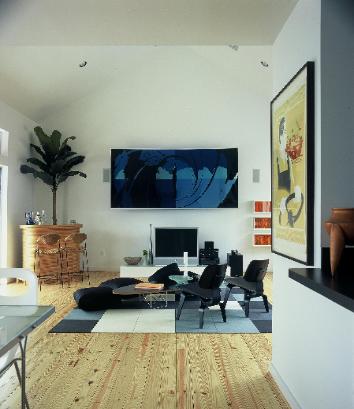It was 1990, and Larry S. Davis was in San Francisco at the opening of an historic building that had been converted into artist-style lofts. The architect had transformed the expansive spaces with their high ceilings and large windows into comfortable and functional living areas, and consequently, there was a waiting list to lease space in the building. As Davis toured the project, he decided to bring the concept to Houston, where he had built a successful business designing and renovating million-dollar custom homes for his clients.
Davis was already aware that young professionals in large cities around the country were reversing the flight to the suburbs that began in the 1950s, seeking instead the excitement and convenience of an urban lifestyle. Davis himself had always lived minutes from his office in central Houston, where explosive growth had doubled the population since 1960. One of the results of such rapid growth was freeways that became nearly impassable at rush hour.
Davis was already planning to develop property owned in the West End, one of Houston’s transitional, close-in neighborhoods. The area had very few historic buildings, however, so he decided instead to construct new loft-style housing. A few months later, on a trip to Santa Fe, Davis saw artists’ studios built with galvanized metal. They appealed to his sense of design, which had always been modernist. He decided to combine the two.
Urban-style lofts for artists, which originated in industrial buildings in Paris and Manhattan, were becoming wildly popular in growing cities like Atlanta, Dallas, Denver, and Seattle. Like them, Davis’s metal-skinned lofts were originally conceived for artists who need spaces flooded with light, along with high ceilings and flexible floor plans, all in a convenient live/work situation.
Davis soon discovered that his loft townhomes appealed to more than just artists—lawyers, doctors, computer programmers, stockbrokers, and empty nesters loved the concept as well. The loft lifestyle appealed to anyone who wanted a more urban lifestyle with easy access to theaters, museums, and restaurants. They were rejecting the suburban lifestyle and all that it represented, including the upkeep of a sprawling ranch-style house and yard. Davis’s clients also liked the large, open space of a loft rather than the traditionally separate living room, dining room, and kitchen. And the security of the townhouses’ design was appealing to women, who could drive into their garages and close the door behind them without having to walk outside. Details that Davis has become known for are livable open floor plans with 17-foot ceilings, secured-access entries, skylights, and extra-large closets.
Background on Larry S. Davis
Over the past 30 years, Larry S. Davis has become one of Houston’s most respected designers. After graduating from the University of Houston School of Architecture in 1975, he traveled around the world for nearly two years, studying all styles of architecture. After completing an internship at a Parisian architectural firm, he established his design business in Houston. Davis’s initial projects were the construction and renovation of custom multi-million-dollar homes for clients in Houston’s best neighborhoods, including River Oaks, Southhampton, and Memorial. He has been published in more than 30 local, national and international publications. In 1989, Davis was honored by the AIA for his interior remodeling of a 1938 home designed by the late Houston architect Karl Kamrath. In 1990, he received acclaim for his renovation and addition to a 1925 John Staub home. In 1991, Davis participated in the Quinta Mostra Internazionale di Architettura, “Una Porta per Venezia” at the Biennale di Venezia. In 1995, Davis completed the renovation of a 1922 William Ward Watkin home in the museum district, nearly doubling the living space while retaining the structural integrity of the design. Davis has designed, among other projects, retail interiors that include the Madison Avenue store Agnona, a cashmere fashion house, and a shoe boutique in Houston. When the University of Houston School of Architecture celebrated its 50th anniversary by honoring 50 of its 2,300 graduates, Davis was among them.

